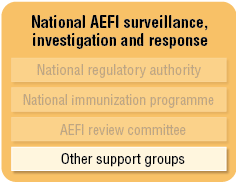Other support groups

Support for the development, implementation and communication of vaccine safety policies and procedures is available to immunization programmes from a range of other national, regional and local organizations.
These include National immunization technical advisory groups![]() National immunization technical advisory groups (NITAGs)Advisory groups whose general objective is to guide national governments and policy-makers to develop and implement evidence-based, locally relevant immunization policies and strategies that reflect national priorities., and pharmacovigilance centres
National immunization technical advisory groups (NITAGs)Advisory groups whose general objective is to guide national governments and policy-makers to develop and implement evidence-based, locally relevant immunization policies and strategies that reflect national priorities., and pharmacovigilance centres![]() National pharmacovigilance centreA governmentally recognized centre (or integrated system) within a country with the clinical and scientific expertise to collect, collate, analyse, and give advice on all information related to drug safety..
National pharmacovigilance centreA governmentally recognized centre (or integrated system) within a country with the clinical and scientific expertise to collect, collate, analyse, and give advice on all information related to drug safety..
Pharmacovigilance centres
The AEFI surveillance functions of pharmacovigilance centres relate to the reporting and investigation of adverse events associated with vaccines as well as medicinal drugs. Many countries now operate a decentralized pharmacovigilance system, with a national pharmacovigilance centre functioning as the focal point for a network of regional and/or local centres. These may be located in a range of organizations, including relevant government departments, hospitals, academic environments, or hosted by a professional body such as a national medical association.
The provision of a high-quality information service to health workers is a basic task of pharmacovigilance centres. Continuous and appropriate educational activities improves knowledge, and stimulates and encourages health workers to report AEFIs.
National immunization technical advisory groups (NITAGs)
Evidence-based information is accessible to NITAGs via the online NITAG Resource Centre. It provides four dedicated services.
NITAG Resource Centre http://www.nitag-resource.orgThe general objective of NITAGs is to guide national governments and policy-makers to develop and implement evidence-based, locally relevant immunization policies and strategies that reflect national priorities. They support national authorities and empower them to address issues associated with:
- Vaccine quality and safety,
- The introduction of new vaccines and immunization technologies.
NITAGs also serve to:
- Reinforce the credibility of national vaccine and immunization policies,
- Help governments and national immunization authorities to resist pressure from vested interest groups,
- Enhance the ability to secure government or donor funding for immunization programmes encourage a more comprehensive approach to immunization policy that:
- Considers the health of vulnerable populations,
- Integrates various pre-existing vaccine-specific task forces.

